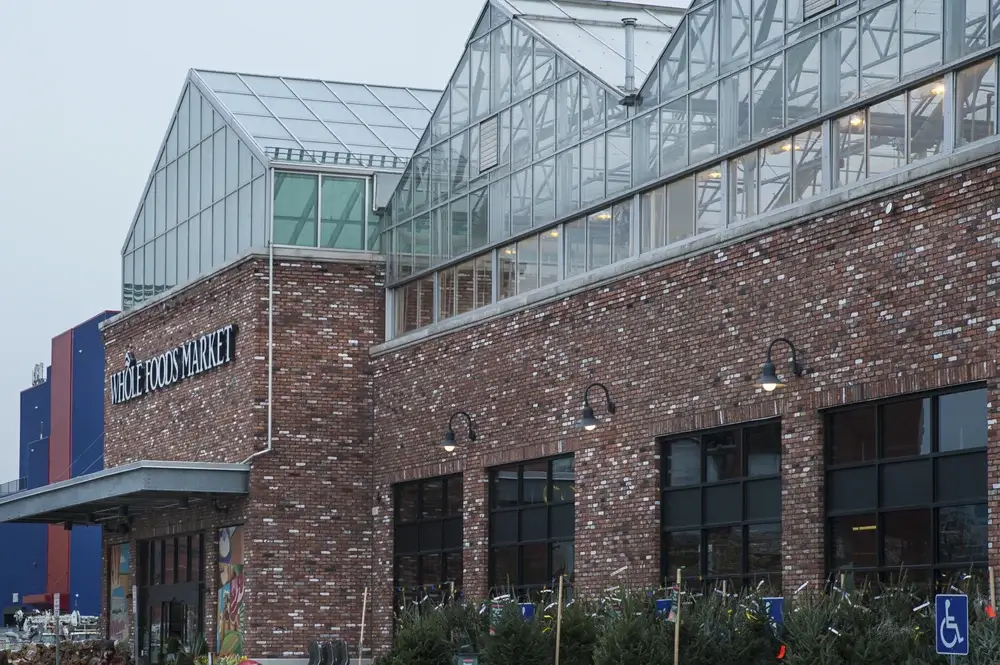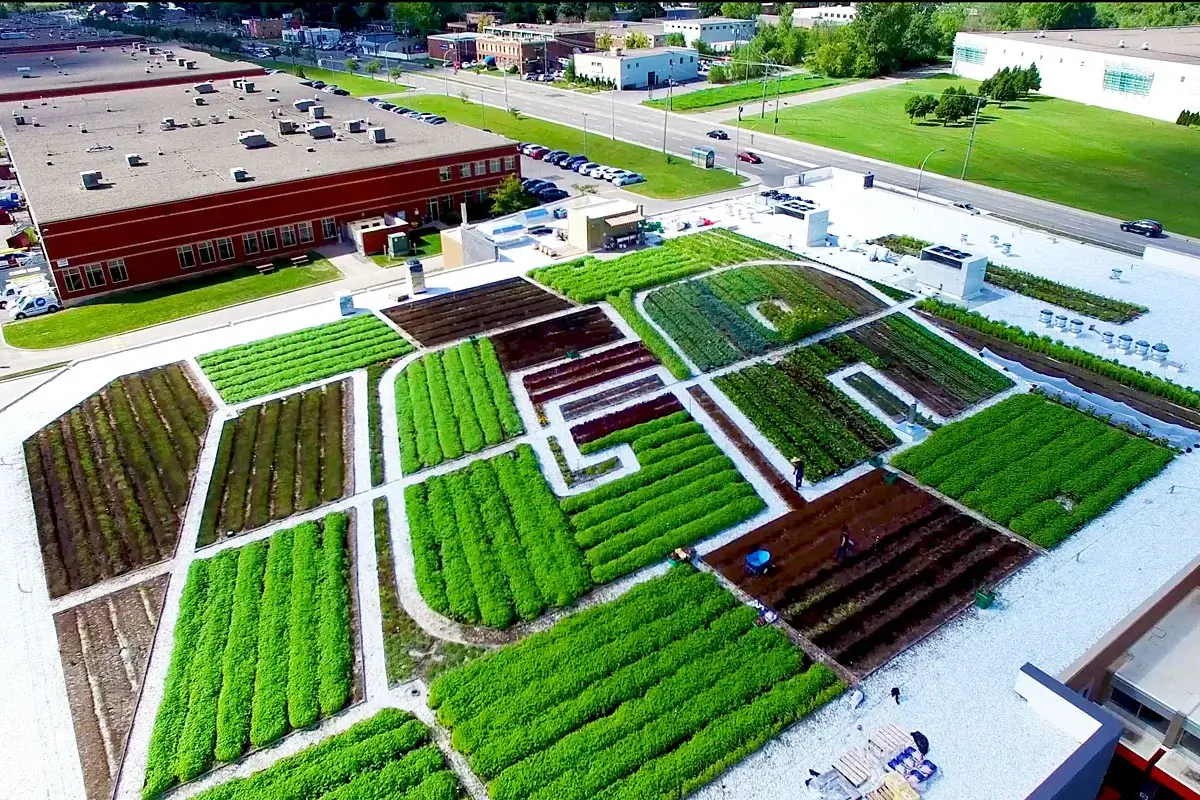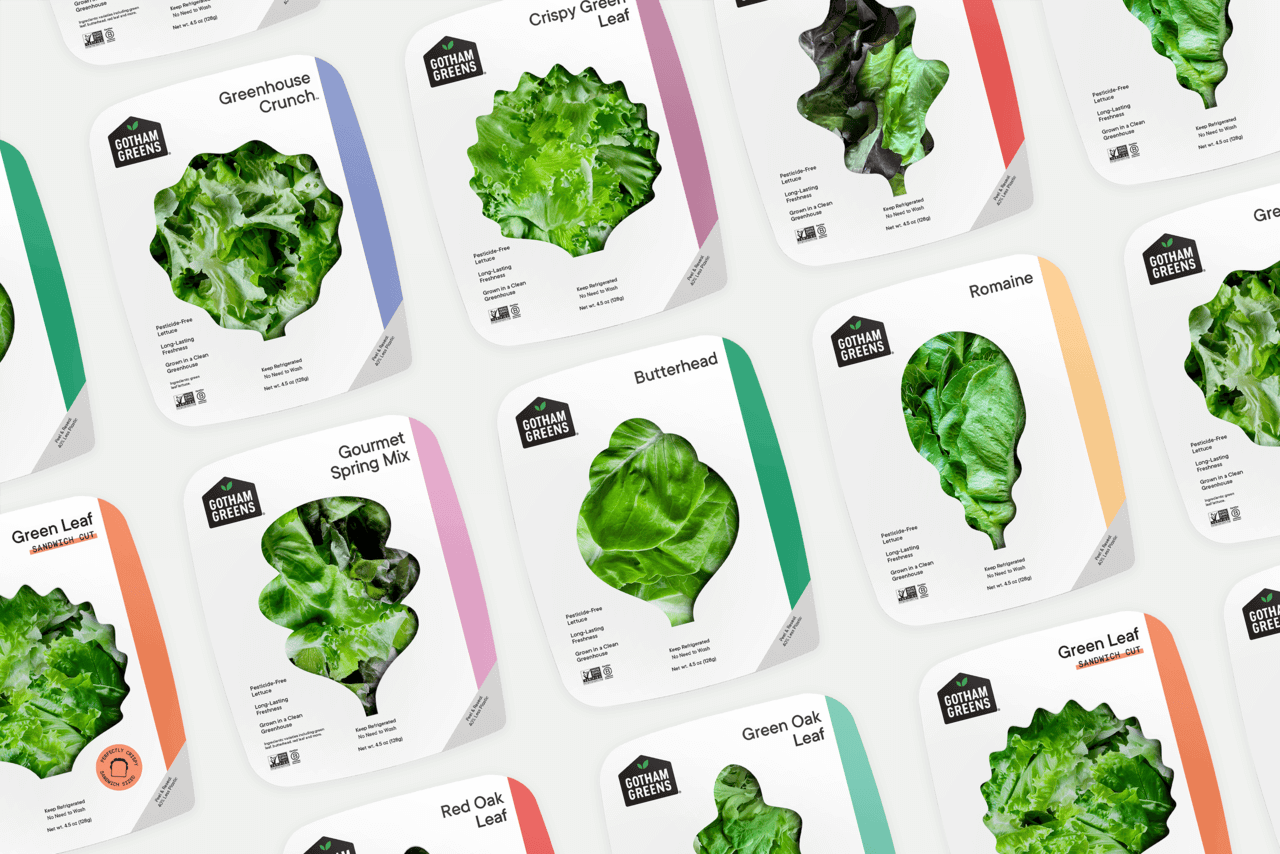On the Ground With Grocery Stores Redefining How Local Food is Produced
Harvested fresh from the parking lot. How grocery stores are breaking down supply chains by growing their own hyper-local produce.
On the Ground With Grocery Stores Redefining How Local Food is Produced
Harvested fresh from the parking lot. How grocery stores are breaking down supply chains by growing their own hyper-local produce.

Whole Foods Market in Gowanus, Brooklyn, NY which features a rooftop greenhouse run by Gotham Greens. Photo by Ana Iacob Photography via Shutterstock
In the produce section of the IGA grocery store in Saint-Laurent, Quebec, a TV monitor shows customers, in real time, the roof of the store and farmers harvesting cucumbers that within an hour will be on store shelves.
When the Food Industry Association asked Americans to list reasons why they buy local produce, 82 percent of those surveyed cited a desire for freshness. Finding fresh local produce in conventional grocery stores, especially in urban settings, is not always easy. Retail distribution systems are designed to deliver products in as few trips as possible. Breaking this down into numerous shorter trips can be time-consuming and expensive. Large grocery store chains often have long-term contracts in place with out-of-state suppliers that are difficult to breach and, therefore, don’t have store capacity for local produce.

Fresh from the parking lot
Despite these drawbacks, across North America, a handful of grocery stores are pioneering a new way of growing that puts hyper-local food at the forefront of the supply chain. For those operating these farms, such as Kelli Ebbs, store manager of Muskoka North Good Food Co-op in Huntsville, Ontario, the two large shipping-like containers in the store’s parking lot have filled a much-needed gap in the supply chain.
“During the growing season, we don’t have a problem procuring fresh greens from local farms,” says Ebbs. In north-central Ontario, however, the growing season is short and, for six to seven months of the year, the store was ordering organic produce from aggregates sourcing produce, sometimes as far away as Mexico. For Ebbs, this was undependable and problematic.
The first container farm was installed in the store’s parking lot approximately a year and half ago. Built in Canada by Growcer and designed for the fluctuations in the Canadian climate, structural insulated panels keep cool air inside during the summer and make working conditions bearable in winter. Currently growing salad greens, cooking greens and herbs, when a second unit comes online this winter, the store will experiment with growing fresh locally grown strawberries. If the popularity of the first unit is any indication, it will be no problem making sales.
“We can harvest 100 units of fresh produce on a Wednesday and, by Saturday, it is gone,” says Ebbs. A half-pound bag of fresh salad greens sells for CDN$8, which is comparable to pre-packaged organic greens sold in any grocery store across Canada. The popularity of the products has meant that Ebbs has been able to cover the continuing operating costs of the vertical farm without it having an impact on store profits.
Ebbs sees a future for the units at her store, but she is also adamant that this type of growing cannot and should not be viewed as a replacement to local farmers or food grown naturally under the sun and rain. “Grocery stores have to continue to support our local farmers and the work they do,” says Ebbs. She vowed when the containers arrived that she would never turn away a local farmer offering fresh produce to the store.
Greenhouses in the sky
“Customers love knowing that we are supporting sustainable methods to expand urban agriculture while being able to offer produce that is fresh and hyper-local,” says Jinah Kim, store team leader at the Third and 3rd Whole Foods in Brooklyn, NY.
Since 2013, hydroponically equipped greenhouses on the roof of the store have been producing salad greens and fresh herbs for the store below. “What we can grow in half an acre in a hydroponic greenhouse would require 15-20 acres in a field,” says Viraj Puri, CEO of Gotham Greens. By growing and marketing crops locally, the need for long-distance food transportation, fuel consumption, and carbon emissions associated with food miles has been eliminated. For Puri, though, this isn’t the biggest impact being made by the farm. “There’s a lot of symbolism around the project,” he says, “and what is possible in making cities green and liveable and in connecting people to the food system.”

In-store signage in the produce section educates the customer about the rooftop farm. For those enjoying lunch in the Whole Foods rooftop cafeteria, a bank of windows overlooks the greenhouse production area, letting customers see up close exactly where the lettuce in their sandwich was harvested.
Whole Foods acts as the landlord, but Gotham Greens owns the greenhouses. Produce under the 20,000-square-foot greenspace is marketed to customers under the Gotham Greens label at prices comparable to organic products sold anywhere else. A 4.5-ounce package of salad greens, for example, sells for $3.99, according to Puri.
Customer loyalty
The Sobeys supermarket chain is one of the largest in Canada, overseeing 1,500 stores under different banners, including the IGA Extra Famille Duchemin in Saint-Laurent. Since 2017, the store has been growing and selling organic produce grown on the store’s open-air roof farm. Designed and built by La Ligne Verte, a company specializing in the design of rooftop growing spaces, the idea initially was to create a green roof. “The IGA being a grocery store,” says Anthime Bion, a landscape architect with La Ligne Verte, “we thought it would be interesting to have a grocery store that was not only a distributor, but also a producer of high-quality organic fresh produce.”
“The most complicated part was the watering,” says Bion. “We had to be permanently connected to the city’s water system to get enough water to water the surfaces.” Weight constraints on the roof makes the use of machinery prohibitive, meaning the work of growing and harvesting has to be done by hand. Finding skilled market gardeners capable of this, Bion acknowledges, can be challenging. Originally managed by the market gardening wing of La Ligne Verte, in 2023, Sobeys contracted the Montreal non-profit organization La Ferme Du Rue to take over the management of the rooftop farm.
Being able to manage the IGA farm provides the non-profit organization with income to run workshops throughout Montreal and in schools that introduce youth to the value and practicalities of urban farming.
“The farm grows exclusively for IGA,” says Réal Migneault, La Ferme du Rue’s founder. “Once harvested, we take it down 44 steps to the store below.” According to Richard Duchemin, the owner of the IGA, the rooftop products increase sales of organic products by 1.5 times over what is normally sold in stores. “The prices are the same as for organic products sold in IGAs stores throughout Quebec,” he says. As with any retail venture, the success depends on the customers’ reactions, who, according to Duchemin, are very proud to be able to contribute to hyper-local purchasing.
This bolsters Migneault’s belief that a business case can be made for more farms such as IGA’s. “If we look at the benefits of the model,” he says, “it builds faithfulness in the customer base who see the store as an actor of change and this builds your brand. Customers have told me they come to this specific store because of the organic vegetables grown on the rooftop.”
Currently, though, IGA’s rooftop farm remains one of a kind in Canada.
Follow us
This work is licensed under a Creative Commons Attribution-NoDerivatives 4.0 International License.
Want to republish a Modern Farmer story?
We are happy for Modern Farmer stories to be shared, and encourage you to republish our articles for your audience. When doing so, we ask that you follow these guidelines:
Please credit us and our writers
For the author byline, please use “Author Name, Modern Farmer.” At the top of our stories, if on the web, please include this text and link: “This story was originally published by Modern Farmer.”
Please make sure to include a link back to either our home page or the article URL.
At the bottom of the story, please include the following text:
“Modern Farmer is a nonprofit initiative dedicated to raising awareness and catalyzing action at the intersection of food, agriculture, and society. Read more at <link>Modern Farmer</link>.”
Use our widget
We’d like to be able to track our stories, so we ask that if you republish our content, you do so using our widget (located on the left hand side of the article). The HTML code has a built-in tracker that tells us the data and domain where the story was published, as well as view counts.
Check the image requirements
It’s your responsibility to confirm you're licensed to republish images in our articles. Some images, such as those from commercial providers, don't allow their images to be republished without permission or payment. Copyright terms are generally listed in the image caption and attribution. You are welcome to omit our images or substitute with your own. Charts and interactive graphics follow the same rules.
Don’t change too much. Or, ask us first.
Articles must be republished in their entirety. It’s okay to change references to time (“today” to “yesterday”) or location (“Iowa City, IA” to “here”). But please keep everything else the same.
If you feel strongly that a more material edit needs to be made, get in touch with us at [email protected]. We’re happy to discuss it with the original author, but we must have prior approval for changes before publication.
Special cases
Extracts. You may run the first few lines or paragraphs of the article and then say: “Read the full article at Modern Farmer” with a link back to the original article.
Quotes. You may quote authors provided you include a link back to the article URL.
Translations. These require writer approval. To inquire about translation of a Modern Farmer article, contact us at [email protected]
Signed consent / copyright release forms. These are not required, provided you are following these guidelines.
Print. Articles can be republished in print under these same rules, with the exception that you do not need to include the links.
Tag us
When sharing the story on social media, please tag us using the following: - Twitter (@ModFarm) - Facebook (@ModernFarmerMedia) - Instagram (@modfarm)
Use our content respectfully
Modern Farmer is a nonprofit and as such we share our content for free and in good faith in order to reach new audiences. Respectfully,
No selling ads against our stories. It’s okay to put our stories on pages with ads.
Don’t republish our material wholesale, or automatically; you need to select stories to be republished individually.
You have no rights to sell, license, syndicate, or otherwise represent yourself as the authorized owner of our material to any third parties. This means that you cannot actively publish or submit our work for syndication to third party platforms or apps like Apple News or Google News. We understand that publishers cannot fully control when certain third parties automatically summarize or crawl content from publishers’ own sites.
Keep in touch
We want to hear from you if you love Modern Farmer content, have a collaboration idea, or anything else to share. As a nonprofit outlet, we work in service of our community and are always open to comments, feedback, and ideas. Contact us at [email protected].by Jennifer Cole, Modern Farmer
September 27, 2024
Modern Farmer Weekly
Solutions Hub
Innovations, ideas and inspiration. Actionable solutions for a resilient food system.
ExploreExplore other topics
Share With Us
We want to hear from Modern Farmer readers who have thoughtful commentary, actionable solutions, or helpful ideas to share.
SubmitNecessary cookies are absolutely essential for the website to function properly. This category only includes cookies that ensures basic functionalities and security features of the website. These cookies do not store any personal information.
Any cookies that may not be particularly necessary for the website to function and are used specifically to collect user personal data via analytics, ads, other embedded contents are termed as non-necessary cookies.
Absolutely love the concept, was rather thrilled to see it in action. Such a positive step in the right direction!